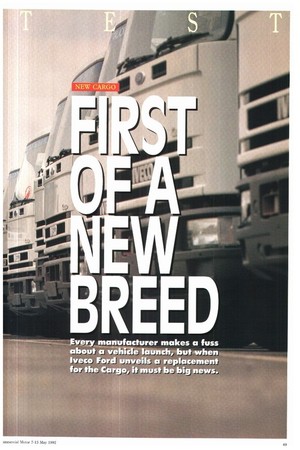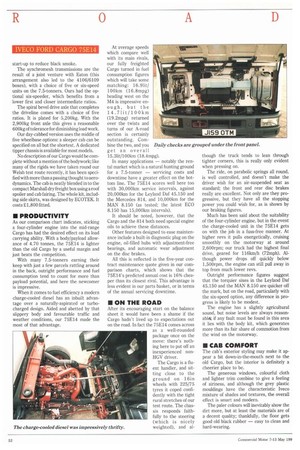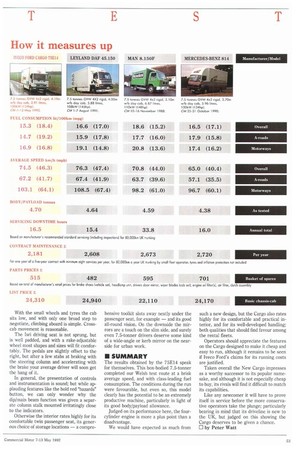BREED
Page 51

Page 52

Page 54

Page 55

If you've noticed an error in this article please click here to report it so we can fix it.
low ...ir._ Every manufacturer makes a fuss about a vehide launch, but when Iveco Ford unveils a replacement fo e Cargo, i ii t be bi.:
Price as tested: £30,686 (ex-VAT). Includes C515 for six-speed gearbox, £361 for exhaust brake, £3,700 for Marshall body and £1,800 for ECOTEK air management package.
Engine: 3.9-litre 100kW (134hp). GVW: 7.5 tonnes. Body/payload: 4.70 tonnes. Speed: 74.5km/h (46.3mph). Fuel consumption: 15.311t/100km (18.4mpg).
Since its launch in 1981, the Cargo 7.5-tonner has found over 58,000 buyers in the UK. Ford might be drifting quietly away from making heavy commercials but that hasn't stopped its last design from becoming the most popular light truck in the business.
Time moves on, however, and with the destiny of Iveco Ford's product line-up being shaped by the Iveco side, it was only a matter of time before the ubiquitous Cargo gave way to a more modern, and a more European, replacement.
Last summer this process began in earnest, with a new team of ducking-and-diving robot welders installed at the Langley production plant, and the appearance of the occasional unfamiliar new face in the rows of chassis parked outside_ Things came to a head in October, when the first stage of the Cargo's replacement — imaginatively christened the New Cargo — was formally launched. Production of the 'old' Cargo is being phased out, and when this process is complete the 'New' tag will doubtless go. The middleweight New Cargos are important enough in the UK, but the new vehicle (badged EuroCargo) also replaces the various Iveco designs previously sold across Europe. It represents the first step in a programme which will see the entire Iveco Ford heavy range transformed over the next couple of years.
All in all the 7.5-tonner has a lot riding on it, and Iveco Ford will be determined to make a go of it. But the task is not an easy one.
Although some features of the old Cargo are carried over (indeed UK engineers have had a reasonable input into the specification), none of the New Cargo's major components will be familiar to UK buyers. The engine, gearbox and drive axle are all Italian-sourced Iveco units; the cab panels and chassis members are also made there.
The package is ranging up against some well established rivals. Leyland Daf has steadily been attracting buyers to its Roadrunner, and its revamped 45 Series is now a serious challenger; Mercedes-Benz has the evergreen 814 family; MAN its 8.150, and with Renault and AWD also chasing customers this is a particularly competitive sector.
• PRODUCT PROFILE
The first stage of the New Cargo family covers the 6-10 tonne GVW sector. The 60E and 65E use four-cylinder engines at 6.0 and 6.7 tonnes; the 75E offers the choice of four and six-pot engines at 7.5 tonnes. Heading the range at 7.5 and 10 tonnes are the six-cylinder 80E and 100E.
The 75E14 7.5-tonner we test here is likely to be one of the big sellers, with a light four-pot engine, and sitting nicely in the popular 90-100kW (120-135hp) power category. The next model up is the sixcylinder 75E15, which gives slightly more torque at the expense of 245kg in payload, All the engines in the range are heavily re-worked versions of Iveco's 8000 Series. The 3.91-litre four in the 75E14 uses air-toair charge-cooling to produce 100kW (134hp) at 2,700rpm and 420Nm (3101bft) at just 1,400rpm.
The surprisingly low engine speed at peak torque is largely accounted for by the use of a wastegate valve on the turbo. This allows the turbo to be tuned to give high boost at low revs, with the wastegate bleeding off excess pressure at higher engine speeds.
The engine, which uses a Bosch rotary pump and five-hole injectors, meets the forthcoming Euro 1 emissions standard. An electronic system monitors coolant temperature and controls fuelling during start-up to reduce black smoke.
The synchromesh transmissions are the result of a joint venture with Eaton (this arrangement also led to the 4106/6109 boxes), with a choice of five or six-speed units on the 7.5-tonners. Ours had the optional six-speeder, which benefits from a lower first and closer intermediate ratios.
The spiral bevel drive axle that completes the driveline comes with a choice of five ratios. It is plated for 5,200kg. With the 2,900kg front axle this gives a reasonable 600kg of tolerance for diminishing load work.
Our day-cabbed version uses the middle of five wheelbase options: a sleeper cab can be specified on all but the shortest. A dedicated tipper chassis is available for most models.
No description of our Cargo would be complete without a mention of the bodywork; like many of the rigids we have taken round our Welsh test route recently, it has been specified with more than a passing thought to aerodynamics. The cab is neatly blended in to the compact Marshall dry freight box using a roof spoiler and cab fairing. The whole kit, including side skirts, was designed by ECOTEK. It costs £1,800 fitted.
• PRODUCTIVITY
As our comparison chart indicates, sticking a four-cylinder engine into the mid-range Cargo has had the desired effect on its load carrying ability. With a body/payload allowance of 4.70 tonnes, the 75E14 is lighter than the old Cargo by a useful margin and just beats the competition.
With many 7.5-tonners earning their keep with just a few parcels rattling around in the back, outright performance and fuel consumption tend to count for more than payload potential, and here the newcomer is impressive.
When it comes to fuel efficiency a modern charge-cooled diesel has an inbuilt advantage over a naturally-aspirated or turbocharged design. Aided and abetted by that slippery body and favourable traffic and weather conditions, our 75E14 made the most of that advantage.
At average speeds which compare well with its main rivals, our fully freighted Cargo turned in fuel consumption figures which will take some matching: 16.9lit/ 100km (16,8mpg) heading west on the M4 is impressive enough, but the 1 4 .7 lit/1 0 Okm (19.2mpg) returned over the twists and turns of our A-road section is certainly outstanding. Cornbine the two, and you Daily checks are gro get an overall
15.3lit/100km (18.4mpg).
In many applications — notably the rental market which is a natural hunting ground for a 7.5-tonner — servicing costs and downtime have a greater effect on the bottom line. The 75E14 scores well here too with 30,000km service intervals, against 20,000km for the Leyland Daf 45.150 and the Mercedes 814, and 10,000km for the MAN 8.150 (as tested; the latest ECO 8.150 has 15,000km intervals).
It should be noted, however, that the Cargo and the 814 both need special engine oils to achieve these distances.
Other features designed to ease maintenance include a built-in diagnostic plug on the engine, oil-filled hubs with adjustment-free bearings, and automatic wear adjustment on the disc brakes.
All this is reflected in the five-year contract maintenance quote given in our comparison charts, which shows that the 75E14's predicted annual cost is 16% cheaper than its closest rival. This advantage is less evident in our parts basket, or in terms of the annual servicing downtime.
• ON THE ROAD
After its encouraging start on the balance sheet it would have been a shame if the Cargo hadn't lived up to expectations out on the road. In fact the 75E14 comes across as a well-rounded package once on the move: there's nothing here to put off an inexperienced nonHGV driver.
The Cargo is a fluent handler, and sitting close to the ground on 16in wheels with 225/75 tyres it coped confidently with the tight rural stretches of our test route. The chassis responds faithfully to the steering (which is nicely weighted), and al
though the truck tends to lean through tighter corners, this is really only evident when pressing on.
The ride, on parabolic springs all round, is well controlled, and doesn't make the driver wish for an air-suspended seat as standard; the front and rear disc brakes really are excellent. Not only are they progressive, but they have all the stopping power you could wish for, as is shown by our braking figures.
Much has been said about the suitability of the four-cylinder engine, but in the event the charge-cooled unit in the 75E14 gets on with the job in a fuss-free manner. At higher revs it pulls energetically, cruising smoothly on the motorway at around 2,600rpm; our truck had the highest final drive, geared for 116km/h (72mph). Although power drops off quickly below 1,500rpm, the engine can still pull away in top from much lower revs.
Outright performance figures suggest that the torquier sixes in the Leyland Daf 45.150 and the MAN 8.150 are quicker off the mark, but on the road, particularly with the six-speed option, any difference in progress is likely to be modest.
The engine has a slightly agricultural sound, but noise levels are always reasonabld; if any fault must be found in this area it lies with the body kit, which generates more than its fair share of commotion from the wind on the motorway.
• CAB COMPORT
The cab's exterior styling may make it appear a bit down-in-the-mouth next to the old Cargo, but the interior is definitely a cheerier place to be.
The generous windows, colourful cloth and lighter trim combine to give a feeling of airiness, and although the grey plastic mouldings have the characteristic Iveco mixture of shades and textures, the overall effect is smart and modern.
The paler colours will inevitably show the dirt more, but at least the materials are of a decent quality; thankfully, the floor gets good old black rubber — easy to clean and hard-wearing. With the small wheels and tyres the cab sits low, and with only one broad step to negotiate, climbing aboard is simple. Crosscab movement is reasonable.
The Isri driving seat is not sprung, but is well padded, and with a rake-adjustable wheel most shapes and sizes will fit comfortably. The pedals are slightly offset to the right, but after a few stabs at braking with the steering column and accelerating with the brake your average driver will soon get the hang of it.
In general, the presentation of controls and instrumentation is sound; but while applauding features like the bold red "hazards" button, we can only wonder why the dip/ main beam function was given a separate column stalk mounted irritatingly close to the indicators.
Otherwise the interior rates highly for its comfortable twin passenger seat, its generous choice of storage locations a compre hensive toolkit slots away neatly under the passenger seat, for example and its good all-round vision. On the downside the mirrors are a touch on the slim side, and surely even 7.5-tonner drivers deserve some kind of a wide-angle or kerb mirror on the nearside for urban work.
• SUMMARY
The results obtained by the 75E14 speak for themselves. This box-bodied 7.5-tonner completed our Welsh test route at a brisk average speed, and with class-leading fuel consumption. The conditions during the run were favourable, but even so, this model clearly has the potential to be an extremely productive machine, particularly in light of its good body/payload allowance.
Judged on its performance here, the fourcylinder engine is more a plus point than a disadvantage.
We would have expected as much from such a new design, but the Cargo also rates highly for its comfortable and practical interior, and for its well-developed handling; both qualities that should find favour among the rental fleets.
Operators should appreciate the features on the Cargo designed to make it cheap and easy to run, although it remains to be seen if Iveco Ford's claims for its running costs are justified.
Taken overall the New Cargo impresses as a worthy successor to its popular namesake, and although it is not especially cheap to buy, its rivals will find it difficult to match its capabilities.
Like any newcomer it will have to prove itself in service before the more conservative operators take the plunge; particularly bearing in mind that its driveline is new to the UK, but judged on this showing the Cargo deserves to be given a chance.
El by Peter Watt




















































































































